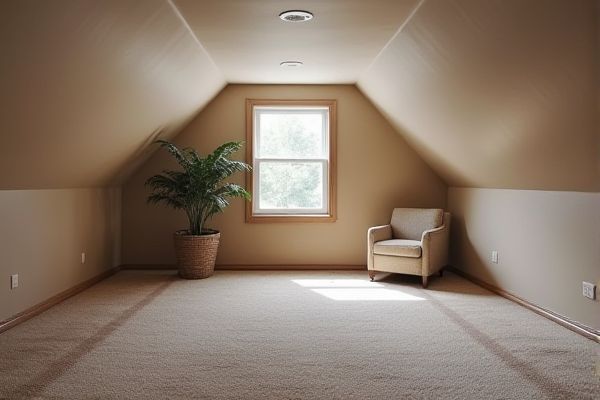
Attic painting storage often exposes artwork to fluctuating temperatures and humidity, risking damage to colors and canvas, while basement storage may offer more stable conditions but can suffer from dampness and mold. To ensure your paintings remain in optimal condition, discover the best practices in the rest of this article.
Table of Comparison
| Feature | Attic Storage | Basement Storage |
|---|---|---|
| Temperature Control | Often unregulated; subject to heat buildup | Usually cooler; risk of dampness |
| Humidity Levels | Can be dry but varies seasonally | Higher humidity; possible mold risk |
| Accessibility | Requires climbing; less convenient | Generally easier access; ground level |
| Safety | Risk of heat damage; structural considerations | Risk of water damage; must monitor for flooding |
| Space Utilization | Often limited by roof slope | Typically more spacious |
| Cost | Minimal; usually existing space | May require waterproofing or dehumidifiers |
| Ideal Contents | Non-sensitive items; seasonal items | Items tolerant to moisture; bulk storage |
Introduction to Attic and Basement Storage
Attic storage offers a dry, elevated space ideal for seasonal items and lightweight belongings, benefiting from natural insulation that helps regulate temperature. Basement storage typically provides cooler, more spacious conditions suitable for heavier goods but can be prone to moisture and requires proper waterproofing to prevent damage. Both storage options vary in accessibility, climate control, and protection levels, influencing the choice depending on the type of items stored.
Climate and Temperature Considerations
Attic storage often faces extreme temperature fluctuations, with summer heat reaching up to 130degF and winter cold dropping below freezing, which can damage sensitive items and paint quality. Basements typically maintain a more stable, cooler climate with higher humidity levels that require proper ventilation to prevent mold and paint deterioration. To protect your belongings effectively, consider climate control options and moisture barriers when choosing between attic painting storage and basement storage.
Humidity and Moisture Risks
Attic storage often faces higher temperature fluctuations but typically lower humidity levels, reducing the risk of moisture damage to painted surfaces. Basement storage tends to have consistently higher humidity and moisture exposure, increasing the likelihood of mold growth and paint deterioration. Ensuring your painted items are stored in a dry, well-ventilated attic can better preserve their condition compared to the damp environment of most basements.
Light Exposure and Its Effects on Paintings
Attic storage exposes paintings to fluctuating light levels and intense sunlight, accelerating fading and color deterioration due to UV radiation. In contrast, basements typically offer darker environments with minimal natural light, significantly reducing the risk of light-induced damage. Controlled lighting in basements helps preserve the artwork's original hues and extends its longevity.
Pest and Mold Prevention
Attic painting storage requires careful sealing and ventilation to prevent moisture buildup, reducing the risk of mold growth on stored items and painted surfaces. Basement storage often faces higher humidity levels and potential flooding, making mold prevention more challenging without proper dehumidifiers and pest control measures. You can minimize pest infestations by using airtight containers and treating both attic and basement areas with appropriate pest repellents.
Security and Accessibility
Attic storage offers enhanced security by limiting unauthorized access due to its elevated and enclosed location, reducing the risk of theft or tampering compared to basement storage, which often has direct entry points. Accessibility in attic storage can be more challenging, requiring ladders or stair access, making frequent retrieval of items less convenient than the typically ground-level and easily navigable basement storage. Choosing between attic and basement storage depends on balancing the need for secure, less accessible placement versus ease of access for regularly used items.
Structural Differences Affecting Storage
Attic storage is influenced by roof slope, ceiling height, and insulation affecting temperature regulation and load capacity, while basements typically offer more stable climate conditions with higher humidity risks due to ground contact. Structural differences such as floor joist strength in attics limit heavy item storage, whereas basement floors can usually support heavier loads but may be susceptible to flooding. Considering Your storage needs, choosing attic or basement spaces depends on the types of items stored and sensitivity to moisture and temperature fluctuations.
Preservation Tips for Stored Paintings
Storing paintings in an attic demands careful climate control to prevent extreme temperature fluctuations and humidity, which can cause canvas warping and paint cracking. Basements, prone to dampness and mold, require dehumidifiers and proper ventilation to safeguard artwork from moisture damage. Using acid-free materials, protective covers, and climate monitors in either location enhances the preservation of stored paintings over time.
Cost Implications of Attic vs Basement Storage
Attic storage typically incurs higher insulation and ventilation costs to protect items from temperature fluctuations and humidity, whereas basement storage demands investment in moisture control and mold prevention systems, increasing maintenance expenses. Renovation costs for attics often involve structural reinforcements to support weight, while basements may require waterproofing and sump pumps, impacting the overall budget. Long-term energy costs can be higher for attic storage due to extreme heat gain in summer and heat loss in winter, whereas basements generally maintain a more stable temperature, reducing climate control expenses.
Choosing the Best Storage Option for Artworks
Choosing the best storage option for artworks requires prioritizing environmental stability, making basement storage preferable due to its typically consistent temperature and humidity levels compared to attics, which are prone to extreme heat and moisture fluctuations. Proper ventilation and insulation in basements help prevent mold growth and material degradation essential for preserving delicate paintings. Attic storage often exposes artworks to direct sunlight and pests, increasing risks of fading and physical damage, thus making basements a safer and more controlled environment for long-term art preservation.
 homyna.com
homyna.com